Samsung Galaxy Nexus & Ice Cream Sandwich Review
by Brian Klug & Anand Lal Shimpi on January 18, 2012 1:34 PM ESTWiFi
The Galaxy Nexus uses Broadcom’s BCM4330, which is starting to pick up steam and become just as ubiquitous as the BCM4329 it replaced. The Galaxy Nexus’ BCM4330 includes both 2.4 and 5 GHz WLAN connectivity, just like the SGS2 in fact. What’s particularly notable is that Android 4.0.x now includes the proper prioritization for each WiFi band, and also includes the ability to set preference for one band for the other. By default, when faced with the same SSID on both 2.4 and 5 GHz, the Galaxy Nexus correctly chooses the 5 GHz AP if the signal is favorable, then falls over to 2.4 GHz when its link quality on that band would be better. Other than this notable change, the remainder of the WiFi settings panes are unchanged. The WiFi sleep preferences and the main scan and connect page does get a minor facelift and change, however.
The Galaxy Nexus latched onto my 802.11n APs on both 2.4 and 5 GHz and used 20 MHz long guard interval rates at 65 Mbps the same as other BCM4330 based devices. Throughput is unsurprisingly very good on the Galaxy Nexus in our WiFi test, which consists of downloading a 100 MB PDF hosted locally over WiFi. Of course, since we can now control and choose which band the device uses, I tested on both 2.4 GHz and 5 GHz, both with a negotiated link rate of 65 Mbps.

WiFi range on the Galaxy Nexus is good as well, I can make it to the same place before hopping off my network as other devices. I have gotten a few emails and read reports about power-save mode incompatibility with some APs that causes it to drop off when on standby mode. Since we've seen BCM4330 work just fine on other devices, I have no doubt this is a software issue which will be fixed soon.
Speakerphone
As usual I also measured speakerphone volume on both variants of the Galaxy Nexus using a sound datalogger. There is apparently a difference between the two models, possibly from different acoustical chambers in the vibration unit and antenna. Also there’s possibly still a difference as a result of the different voice coders in use, and the different dynamic range.
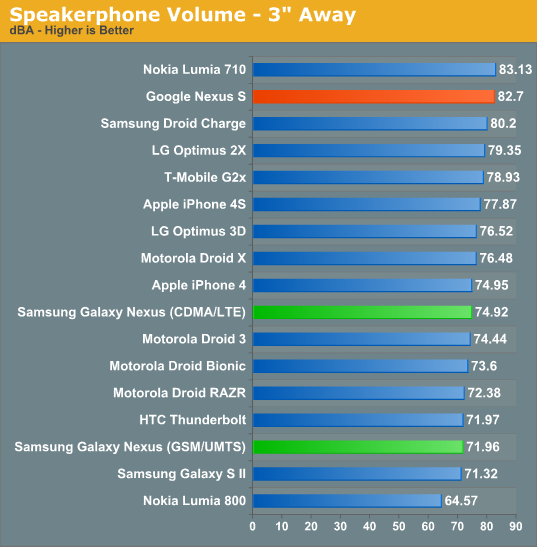
Either way, the two test differently, and subjectively my experience backs those measurements up. I found the GSM/UMTS Galaxy Nexus a bit too quiet while using Google Navigation, and the CDMA/LTE Galaxy Nexus on the quieter side but totally useable for Navigation.
GPS
Just like the SGS2, the Galaxy Nexus uses a SiRFStarIV GSD4t for GPS. Subjectively the Galaxy Nexus GPS doesn’t lock quite as fast as some of the other GNSS solutions that are integrated into the cellular basebands in phones, but it does get the job done pretty fast. I see a time to first fix of between 4-7 seconds depending on visible sky swath presented to the handset.
I did receive a few emails from readers with reports of some Galaxy Nexuses shipping with GPS issues or taking too long to lock. One of my friends with a CDMA/LTE Galaxy Nexus also reported that he couldn’t get a GPS lock at all for Google Navigation. I’m not entirely sure what the deal is here since I never was able to encounter this behavior, although manually downloading the A-GPS data (ephemeris) using a tool like GPS Status seems to in general helps mitigate those problems when they do happen. This just manually re-downloads the xtra.bin file from http://xtra1.gpsonextra.net/xtra.bin as configured in gps.conf. I have to admit that I didn’t encounter any GPS issues in my time with the Google Nexus (CDMA/LTE or GSM/UMTS version) so far.
Audio
We’re going to do a more in-depth audio analysis with the Galaxy Nexus when we have our testing suite more fleshed out, and possibly bring you Francois Simond’s thoughts once more. For now however, we have some RMAA runs I talked about a while ago in another review, and my own impressions with Galaxy Nexus sound after using the device for a while now as my primary music player with some Shure SE535s.
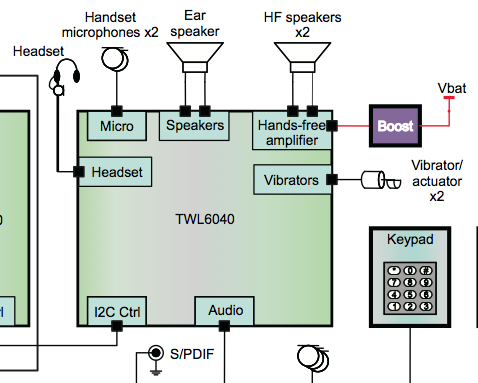
First off, the Galaxy Nexus out of the box is pretty decent subjectively. The Galaxy Nexus uses TI’s TWL6040 low power audio codec for its DAC and other audio responsibilities, alongside the vibrator actuator. We’ve seen some other TI audio codecs (like AIC3254 in the HTC Sensation) but this our first time seeing TWL6040. Almost immediately I noticed that there isn’t any constant high frequency whine present like I’ve heard on so many phones lately (Bionic, SGS2, others), and it’s hard to hear any noise when the DAC turns on and off after music stops playing. Even plugged into USB power, the device also doesn’t pick up any more noise or change at all. There’s also almost no CPU noise, though if you listen very carefully you can indeed hear some state changes, but it’s very minimal and very difficult to pick out.
Though the frequency response isn’t entirely flat as shown, the Galaxy Nexus doesn’t sound bad subjectively. Our testing here is just a RMAA run from line out on the devices to line in on an ASUS Xonar Xense sound card. In addition, testing is done at 44100/16 bit on the devices - Android will downsample anything more than this.

From 20 Hz to 20 kHz: +0.10, -0.62 (dB)
Noise on the Galaxy Nexus also isn’t bad, definitely better than the RAZR we tested earlier.

Noise Level: -96.2 (dB, A weight)
Dynamic range shows the difference in level between the maximum output and minimum output on the smartphone. This is limited by voltage swing and system noise. Galaxy Nexus again here looks pretty good, minus a few spikes.

Dynamic range: 96.0 (dB, A weight)
The two total harmonic distortion charts are next, which are the summation of integer multiples of the test frequency and expressed as a ratio of the input signal (in this case at 1 kHz). THD+Noise gives all frequencies except the input signal. The Galaxy Nexus is pretty good here, but still has some spikes at a few noteworthy integer multiples, plus some odd spikes at high frequencies.
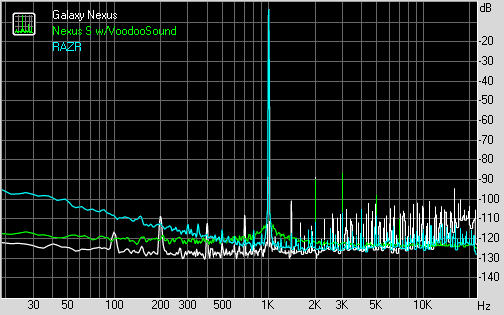
THD %: 0.0088
Intermodulation distortion is similar to total harmonic distortion, however it applies two input signals and then measures the signal at all frequencies except the two inputs. In this case, the two signals are on opposite sides of the spectrum. Galaxy Nexus ends up not looking too bad here although there are disconcerting spikes above 1 kHz that I can’t explain.
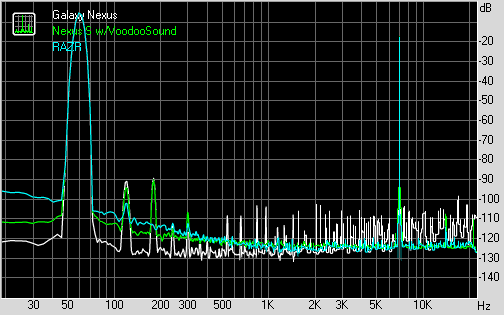
IMD + Noise %: 0.013
Finally stereo crosstalk is pretty flat on the Galaxy Nexus.

Stereo Crosstalk: -87.4 dB
Again, this isn’t meant to be a totally comprehensive analysis of the Galaxy Nexus’ sound characteristics, just some educated impressions. Subjectively the Galaxy Nexus sounds nice and clean, and is absent of the annoyingly audible background noise and whine that’s present on some of the other noteworthy phones we’ve tried as of late. Francois (supercurio) has expressed a few times that the Galaxy Nexus has good audio potential, and that alone should tell you something.


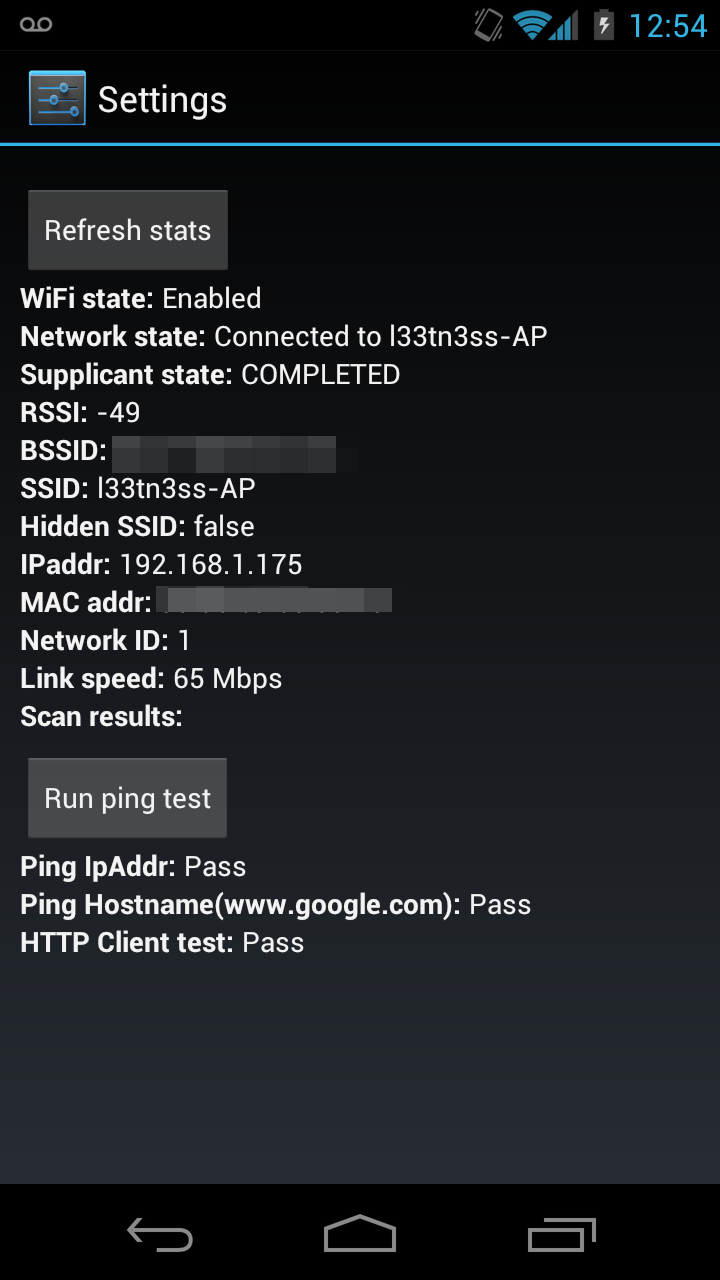
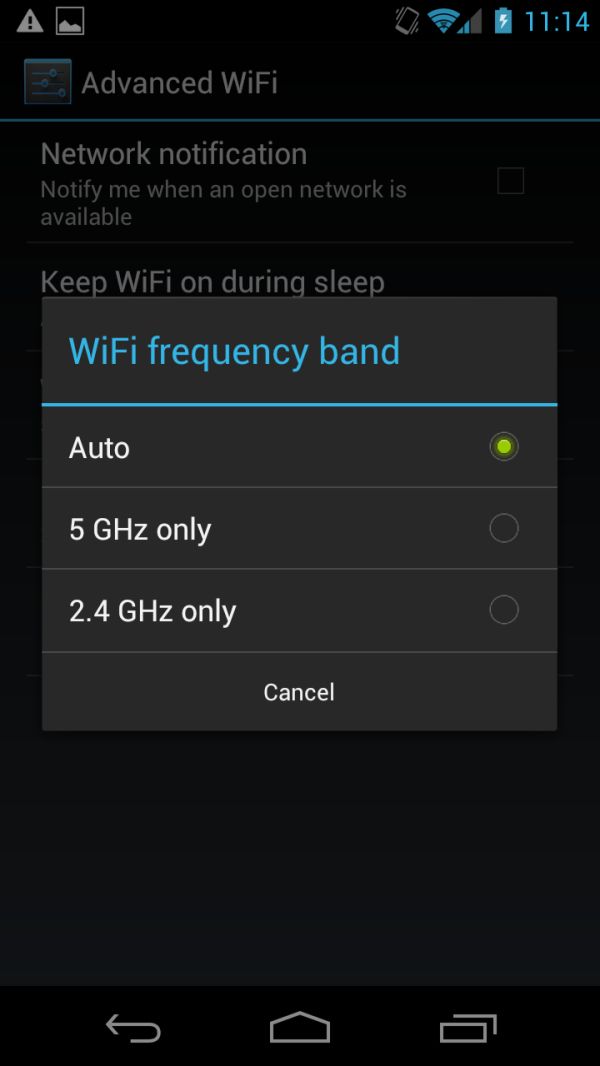
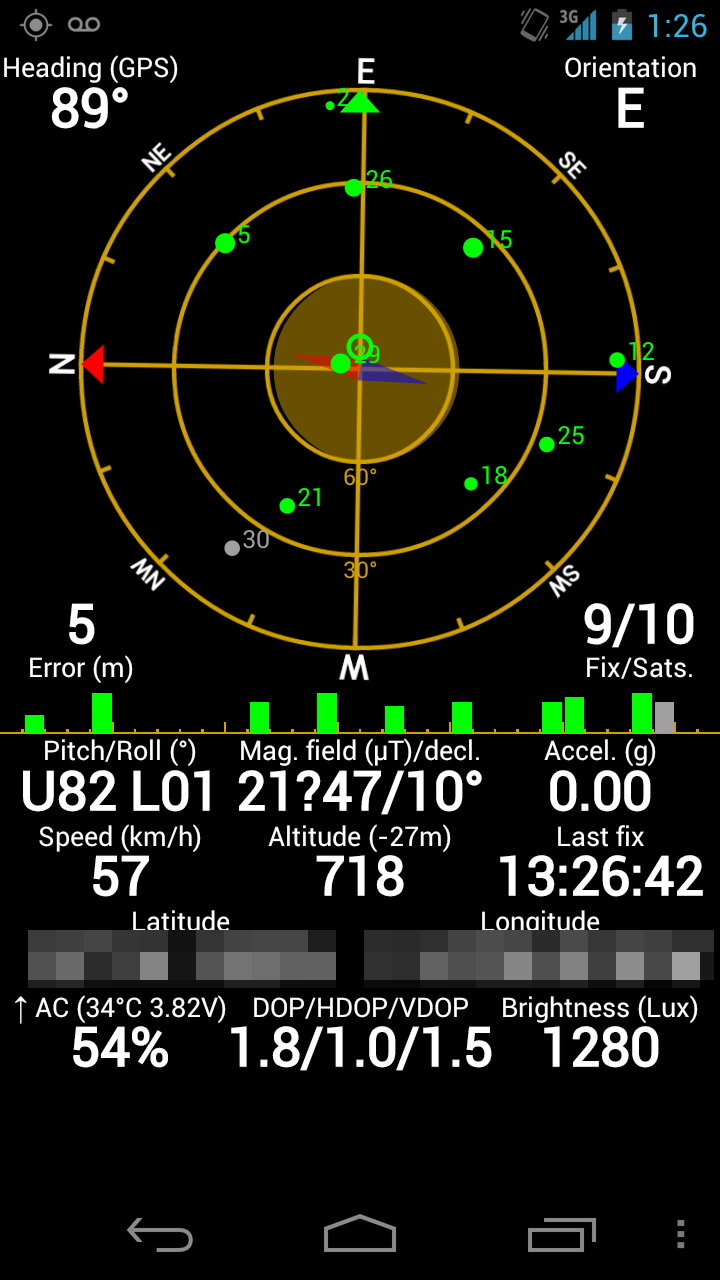








185 Comments
View All Comments
zorxd - Thursday, January 19, 2012 - link
And what exactly is more efficient?c4v3man - Thursday, January 19, 2012 - link
Their implimention of pseudo-multitasking as opposed to the much more flexible multitasking in Android.erple2 - Friday, January 20, 2012 - link
Bingo!Since the iOS can't do "true" multitasking, primarily as a design decision on Apple's part to greatly improve battery life (seen the battery life numbers on WebOS? They're pretty terrible), the requirements for memory are generally quite a bit lower than for Android.
You could argue all day as to which one is better, and still not come up with a clear winner. This is strictly due to the phone form factor. Given the limitations on usable screen size (can't display 2 apps at once reliably), and that you have to rely on battery life, the argument of which is "better" is more difficult to make. These all disappear when power is no longer a serious concern (desktop), nor physical screen display (notebook through desktop).
zorxd - Friday, January 20, 2012 - link
yeah and DOS is better because it works fine with only 1MB RAM.OCedHrt - Friday, January 20, 2012 - link
Which is fine due to fast app switching.trob6969 - Wednesday, January 18, 2012 - link
You didn't have to sacrifice GPU performqnce for a 4.3 inch 720p HD display. You could have done what i did and got an htc rezound. I downloaded Dead space, which is probably one of the most GPU demanding games for a phone, and gameplay is FLAWLESS on it! ZERO choppiness throughout the game. My rezound plays this game just as smoothly as my playstation 3. That says a lot about a phone's performance.metafor - Wednesday, January 18, 2012 - link
Note that with the increased clockspeed to the SGX540, the OMAP4460 matches the GPU performance of a Snapdragon S3 (used in the Rezound).Both chips perform similarly with the CPU clock at 1.2GHz (compare Sensation 4G to GN, for example).
dwang - Wednesday, January 18, 2012 - link
Deadspace runs perfectly fine on the galaxy nexus. No choppiness or slowdown.Zoomer - Thursday, January 19, 2012 - link
TI probably didn't anticipate the move to such high resolutions. The 540 was probably chosen as a good enough solution, given the power reqs are well.This is where Apple's hardware-software codesign wins out.
Johnmcl7 - Wednesday, January 18, 2012 - link
That reasoning that microSD cards are too slow seems to only apply to some of the cheap phones which pretty only use micro SD storage, for a phone like the Nexus it doesn't matter as you say because the micro SD card is for storage rather than applications. I don't really understand why the Nexus doesn't get a harder time for the lack of microSD storage given the relatively low onboard storage and high spec which means it can play back high resolution video which needs quite a bit of space. It's one of the main reasons I went for the Note instead which has the better camera, faster GPU and the micro SD storage allowing me to add 32GB very cheaply (and more down the line when 64GB cards come down in price) which is pretty necessary as the high resolution video recording and other features chew through space very quickly.John